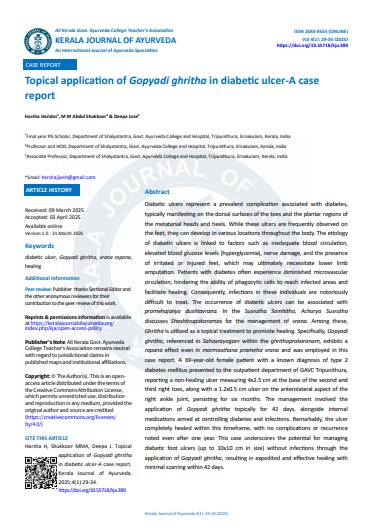Topical application of Gopyadi ghritha in diabetic ulcer-A case report
DOI:
https://doi.org/10.55718/kja.389Keywords:
diabetic ulcer, Gopyadi ghritha, vrana ropana, healingAbstract
Diabetic ulcers represent a prevalent complication associated with diabetes, typically manifesting on the dorsal surfaces of the toes and the plantar regions of the metatarsal heads and heels. While these ulcers are frequently observed on the feet, they can develop in various locations throughout the body. The etiology of diabetic ulcers is linked to factors such as inadequate blood circulation, elevated blood glucose levels (hyperglycemia), nerve damage, and the presence of irritated or injured feet, which may ultimately necessitate lower limb amputation. Patients with diabetes often experience diminished microvascular circulation, hindering the ability of phagocytic cells to reach infected areas and facilitate healing. Consequently, infections in these individuals are notoriously difficult to treat. The occurrence of diabetic ulcers can be associated with pramehajanya dushtavrana. In the Susrutha Samhitha, Acharya Susrutha discusses Shashtirupakaramas for the management of vrana. Among these, Ghritha is utilized as a topical treatment to promote healing. Specifically, Gopyadi ghritha, referenced in Sahasrayogam within the ghrithaprakaranam, exhibits a ropana effect even in marmasthana prameha vrana and was employed in this case report. A 69-year-old female patient with a known diagnosis of type 2 diabetes mellitus presented to the outpatient department of GAVC Tripunithura, reporting a non-healing ulcer measuring 4x2.5 cm at the base of the second and third right toes, along with a 1.2x0.5 cm ulcer on the anterolateral aspect of the right ankle joint, persisting for six months. The management involved the application of Gopyadi ghritha topically for 42 days, alongside internal medications aimed at controlling diabetes and infections. Remarkably, the ulcer completely healed within this timeframe, with no complications or recurrence noted even after one year. This case underscores the potential for managing diabetic foot ulcers (up to 10x10 cm in size) without infections through the application of Gopyadi ghritha, resulting in expedited and effective healing with minimal scarring within 42 days.





